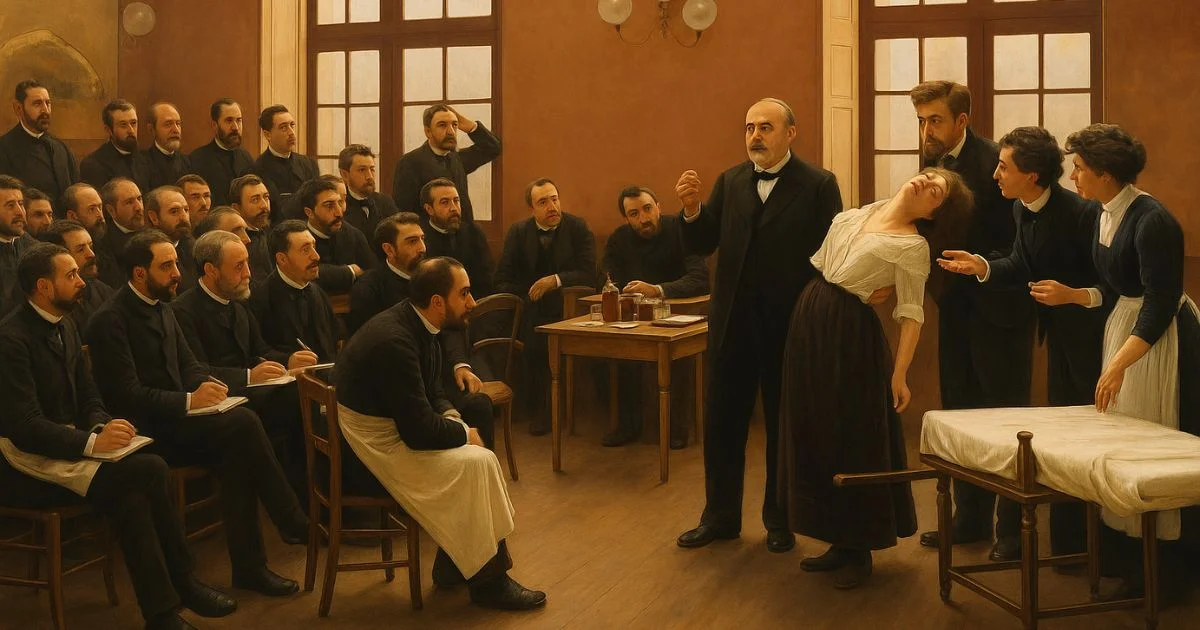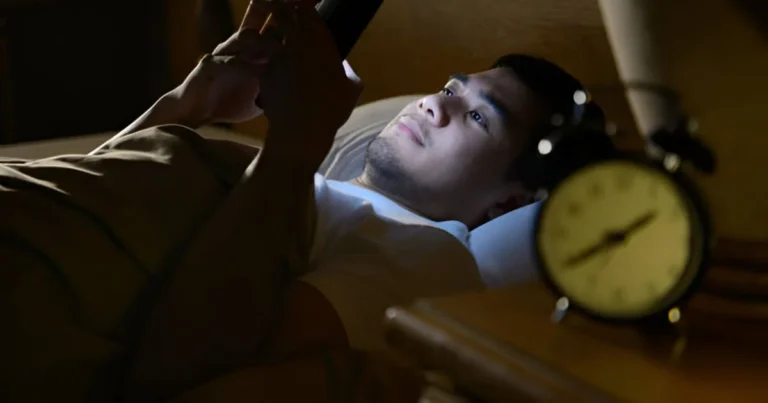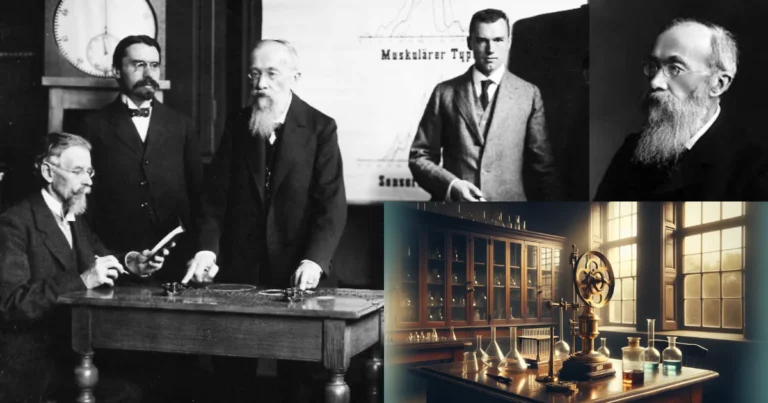From hysteria to science: The legacy of Jean-Martin Charcot
On a December morning in 1885, the lecture hall of the Salpêtrière Hospital in Paris is packed to the brim. In the front rows: physicians from Berlin, Vienna, and London. Beside them sit writers, philosophers, journalists. All have come to witness what are already known as “Tuesday Lectures.” That day, a young woman enters the room. Her name is Augustine, one of the hospital’s most renowned “hysterics.” She is placed on an examination table, under the weight of silent stares. A physician speaks to her in a low voice. Moments later, her body tenses. Her breathing quickens. Her limbs stiffen, then contort violently. Her eyes fixate on a point in the distance, her lips murmur something incomprehensible. The amphitheater falls completely silent. This isn’t theater. It’s a seizure. And everyone is watching.
At the center, standing calmly, a man leads the session. He never raises his voice. He describes, comments, analyzes. He notes the position of the arms, the twist of the neck, the tension of the eyelids. Every movement, every spasm becomes a clue, a sign to be interpreted. His name is Jean-Martin Charcot. And in this space once relegated to misery, he is laying the foundations of a new science: clinical neurology.
A science born from the margins
Charcot was born in 1825 to a family of Parisian craftsmen. At medical school, he stood out for his meticulousness and acute powers of observation. But he quickly moved away from grand theoretical abstractions. What drew him in were tissues, nerves, lesions. He spent countless hours in hospitals, examining bodies, sketching them, uncovering truths through autopsies that words often ignored.
In 1862, he was appointed chief physician at the Salpêtrière. At the time, the institution was a closed world: nearly five thousand women confined there under often inhumane conditions. Some were elderly, others deemed “insane,” many simply had nowhere else to go. Charcot would transform this place of exclusion. He built observation rooms, an amphitheater, a library, a pathology lab. He demanded detailed records, regular documentation, accurate drawings. What once resembled a prison gradually evolved into a center for medical research.
🔗 Read also: The philosophical blueprint of psychology: From Plato to Freud
But Charcot wasn’t merely seeking to cure, he was seeking to understand. What he pursued were not just symptoms but the laws that governed them. To him, illness was not a chaotic disorder but a structure, a logic that could be revealed through careful observation. This conviction, unyielding and almost obsessive, drove him to turn the Salpêtrière into a cornerstone of modern medicine.
Making the body speak without words
Charcot became particularly captivated by so-called functional disorders, especially hysteria. At the time, such symptoms were often dismissed as theatricality, manipulation, or outright fakery. Charcot rejected these moralizing views. He showed that suffering could be real, even in the absence of visible brain lesions. He developed a classification of hysterical phases, detailing every bodily expression. He sought to link these manifestations to functional disruptions in the nervous system.
The “Tuesday Lectures” quickly became a fixture of Parisian medical life. There, symptoms were not only observed but clinically staged, dissected with rigor, sometimes even reproduced under hypnosis. This strange theater fascinated as much as it divided. But for a young physician from Vienna, it was nothing short of revelatory.
In 1885, Sigmund Freud received a grant to study under Charcot. For several months, he attended these demonstrations, took extensive notes, and translated Charcot’s writings into German. This experience marked a decisive turning point. Before he developed psychoanalysis, Freud was first and foremost a disciple of Charcot. In Paris, he discovered that hysteria was not mere simulation but a genuine neurological phenomenon, governed by mechanisms yet to be understood. This insight, gained under Charcot’s influence, would later form the bedrock of Freud’s own work. The transfer was gradual: Charcot studied the body; Freud would pursue its echo in memory.
🔗 Explore further: When the brain meets Da Vinci: The neuroscience behind the Mona Lisa’s mystique
When contemporary science proves him right
More than a century after Charcot’s death, research in functional neurology has begun to confirm what he once intuited but could not yet prove. In his time, there were no tools to observe brain activity in real time. He relied solely on clinical observation, precise description, and scientific intuition. Still, he defended the notion that a constellation of symptoms, convulsions, paralysis, loss of voice, sensitivity, or coordination, were not the product of malingering or theater, but of disrupted brain function, even in the absence of visible lesions.
Back then, these symptoms were grouped under the term “hysteria,” a label now abandoned for its sexist and reductive connotations. It encompassed a range of disorders commonly seen in women: sudden paralysis, anesthesia, cataleptic episodes, or mutism, none of which were accompanied by identifiable organic damage. Medical tests revealed nothing. And yet, the suffering was undeniable. Where many of his contemporaries saw exaggeration or emotional instability, Charcot discerned genuine neurological dysfunction, not localized in visible damage, but rooted in the dynamic circuits of the living brain.
Today, the medical perspective has evolved. The term “hysteria” has been replaced by “Functional Neurological Disorders” (FND). This shift in terminology reflects a major conceptual breakthrough: these are now recognized as legitimate neurological conditions, involving impaired brain function without detectable structural causes. It marks a move toward a more nuanced, respectful, and scientifically grounded understanding of these long-misunderstood symptoms.
🔗 Discover more: Animal magnetism: Mesmer’s intuitive glimpse into the unconscious
What Charcot sensed through empirical observation has been confirmed by contemporary science. In 2012, a landmark study published in The Lancet Neurology by British neuropsychiatrists Simon Wessely, Jon Stone, and Anthony David found that nearly 15% of patients seen in neurology clinics exhibit such symptoms, debilitating motor or sensory issues with no structural anomalies. Their MRIs and EEGs are normal, and yet the symptoms persist: paralysis, tremors, transient blindness, unexplained loss of consciousness. Once neglected, these patients are now better understood and their suffering finally acknowledged as real, beyond the visible.
Much of this progress is due to advances in functional brain imaging, especially fMRI, which allows scientists to observe brain activity in real time. Unlike traditional scans that show brain structure, functional imaging highlights the regions activated during a movement, or even the attempt to move. That same year, researchers at the University of Edinburgh published a study in Brain, comparing patients with functional paralysis to healthy controls. They found atypical activity in motor and prefrontal areas, especially those involved in voluntary movement and bodily attention.
In other words, these patients’ brains operate as if the movement is blocked, not because the muscles or nerves are damaged, but because the circuits responsible for voluntary control fail to transmit the correct command. The action is planned, the intention is there, the neural systems are engaged, but the execution never happens. The brain prepares the gesture, but the signal remains suspended. As Charcot had anticipated, the symptom is not imagined, it emerges from a distinct neurofunctional organization, where volition and automatism fall out of sync.
When the body misreads itself
More recently, in 2024, a new study shed light on an often-overlooked aspect of FND: interoception, the brain’s ability to sense and interpret internal bodily signals like heartbeat, breathing, and muscle tension. Though subtle, this function is crucial for emotional regulation, bodily awareness, and overall sensory integration. The study revealed that FND patients show significant impairments in interoceptive processing. Specifically, decreased activity was observed in key brain areas such as the right anterior insula and the dorsal anterior cingulate cortex, regions responsible for integrating internal bodily signals.
These abnormalities may distort how the body is perceived: internal signals are either misread or amplified. This misinterpretation can trigger inappropriate motor, sensory, or autonomic responses, sudden paralysis, fainting, or unexplained pain, resulting in functional symptoms without any identifiable lesion.
🔗 Read also: Reading minds in bone: The rise and fall of Phrenology
These findings suggest that FND symptoms do not arise from a split between body and brain, but from a breakdown in internal communication, a failure to properly prioritize and integrate bodily information. The problem does not lie in the patient’s imagination, but in a measurable disruption of their interoceptive system.
Charcot’s relevance today
Jean-Martin Charcot died in 1893 at the age of 67. He left behind more than a name in medical textbooks. He left a method, an attitude, a way of approaching illness that values patience over haste, observation over assumption, and listening before diagnosis. He trained a generation of pioneers who continued his legacy in their own ways: Joseph Babinski, who identified the reflex that bears his name; Pierre Janet, who explored the links between trauma, memory, and dissociation; Georges Gilles de la Tourette, who gave his name to a still-misunderstood syndrome. All drew from Charcot the same founding principle: that suffering deserves to be studied with both rigor and respect.
His legacy is also a stance toward the complexity of life, a way of approaching illness not as a defect to eliminate but as a message to decode. He never reduced patients to malfunctions. He sought to understand how a life, a trajectory, a story could be inscribed in gestures, silences, and bodily breakdowns. He reminds us that slow listening is itself a form of care, because the body does not lie, but we must still learn how to hear what it’s trying to say in its own language.
References
Carle-Toulemonde, G., Garcin, B., & Hingray, C. (2020). Au revoir l’hystérie… bonjour les troubles neurologiques fonctionnels : la place du psychiatre. Revue Neurologique, 176(S138–S141).
Charcot, J.-M. (1885). Leçons sur les maladies du système nerveux faites à la Salpêtrière. Paris : Delahaye et Lecrosnier.
Didi-Huberman, G. (1982). Invention de l’hystérie : Charcot et l’iconographie photographique de la Salpêtrière. Paris : Macula.
Edwards, M. J., Adams, R. A., Brown, H., Pareés, I., & Friston, K. J. (2012). A Bayesian account of ‘hysteria’. Brain, 135(11), 3495–3512.
Goetz, C. G. (2001). Charcot: Constructing neurology. Oxford University Press.
Sojka, P., Serranová, T., Khalsa, S. S., Perez, D. L., & Diez, I. (2025). Altered Neural Processing of Interoception in Patients With Functional Neurological Disorder: A Task-Based fMRI Study. The Journal of neuropsychiatry and clinical neurosciences, 37(2), 149–159.
Stone, J., Carson, A., & Wessely, S. (2012). Functional symptoms and signs in neurology: Assessment and diagnosis. Lancet Neurology, 11(2), 118–128.

Sara Lakehayli
PhD, Clinical Neuroscience & Mental Health
Associate member of the Laboratory for Nervous System Diseases, Neurosensory Disorders, and Disability, Faculty of Medicine and Pharmacy of Casablanca
Professor, Higher School of Psychology







